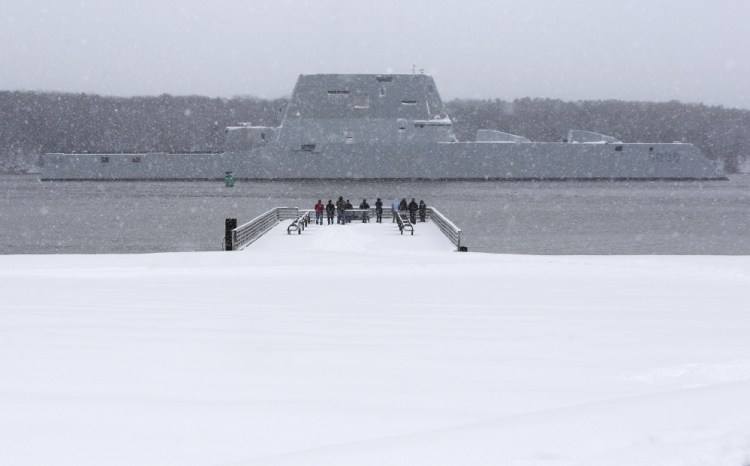Bath Iron Works, one of Maine’s largest employers, is in line for steady funding of the ships awarded to the yard, even as it grapples with reining in costs for its showpiece destroyer.
A top-level Navy official told a Senate Armed Services Committee panel Wednesday that it is seeking $81.4 billion to buy 38 warships, submarines and support vessels in the next five years. For BIW, that means the funding process moves forward for ships already under contract to be built at the shipyard, said BIW spokesman Matt Wickenheiser.
“The Navy is seeking funding for ships that have already been contracted,” he said. “We need that funding to go forward.”
BIW, which employs 6,100 people, has seven Navy ships under construction and another four under contract. Three of the ships under construction are Zumwalt-class guided missile destroyers. The other four under construction are Arleigh Burke-class guided missile destroyers. The four under contract also are Arleigh Burke destroyers.
Assistant Secretary for Acquisition Sean Stackley outlined the Navy’s plans, saying the $81.4 billion funding proposal for fiscal 2017 through 2021 keeps with the Navy’s five-year plan, Bloomberg News reported.
Meanwhile, costs for the Zumwalts are running about 3.7 percent, or $450 million, above estimates from the last fiscal year. Revised costs for the three ships is about $12.74 billion, according to The Associated Press.
USNI News, a publication of the U.S. Naval Institute, reported Wednesday that unnamed Navy officials blamed “performance issues” at BIW for the cost overruns for the three Zumwalt destroyers.
Citing Navy and congressional sources, USNI reported, “The cost was in large part due to the performance of the shipyard in completing the construction of the Zumwalts – which feature a complex first-of-type integrated power system that has proved harder-than-expected for the Navy and BIW to build and test.”
Delays and overruns are a common occurrence with “lead” ships in a new class. The projected cost is about 1 percent above the acquisition program baseline established in 2011, said Navy spokeswoman Capt. Thurraya Kent.
Loren Thompson, a defense analyst at the Lexington Institute, said the Navy’s decision to serve as systems integrator, instead of leaving the task to the shipyard, likely contributed to the delays and overruns, the AP reported.
The first Zumwalt completed at Bath underwent recent sea trials, and is scheduled to be delivered to the Navy this spring.
The Navy’s funding request is reassuring to General Dynamics Corp., which owns BIW, as well as other defense contractors, including Lockheed Martin Corp. and Austal Ltd. The five-year figures also are important to investors and analysts, as well as lawmakers in Maine, Connecticut, Virginia, Alabama and Mississippi, where shipyards are located.
The plan calls for spending about $14.7 billion on seven vessels next year, $16.8 billion on eight in fiscal 2018, $16.2 billion on seven in 2019, $16.9 billion on eight in 2020 and $16.8 billion on eight vessels in 2021.
The five-year plan also updates funds to start work on replacing the Ohio-class nuclear missile submarine, which will benefit General Dynamics’ operation in Groton, Connecticut. The Navy plans to spend $9.25 billion through fiscal 2021, up from the $5.7 billion it planned to spend through 2020 in last year’s plan. The Navy last week announced that General Dynamics will be the prime contractor, and will receive a contract later this year to produce the diagrams, drawings and information necessary to start construction of the new sub.
Send questions/comments to the editors.




Comments are no longer available on this story